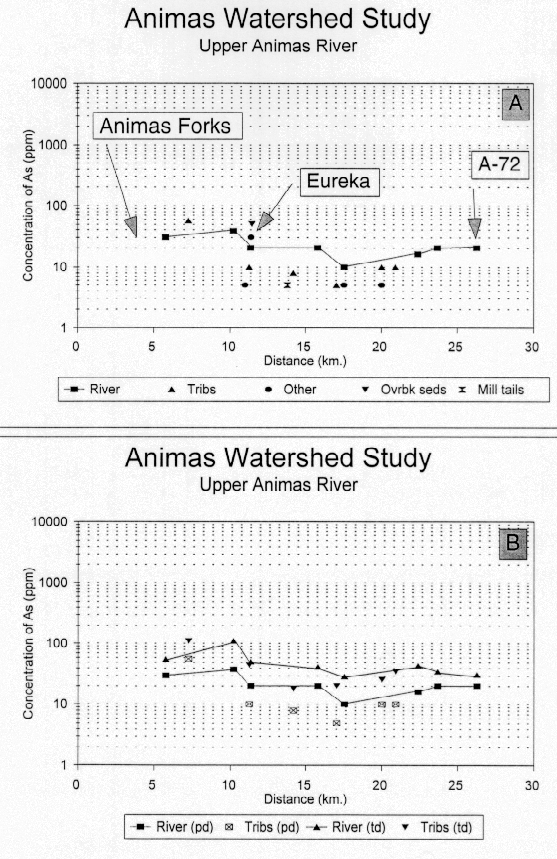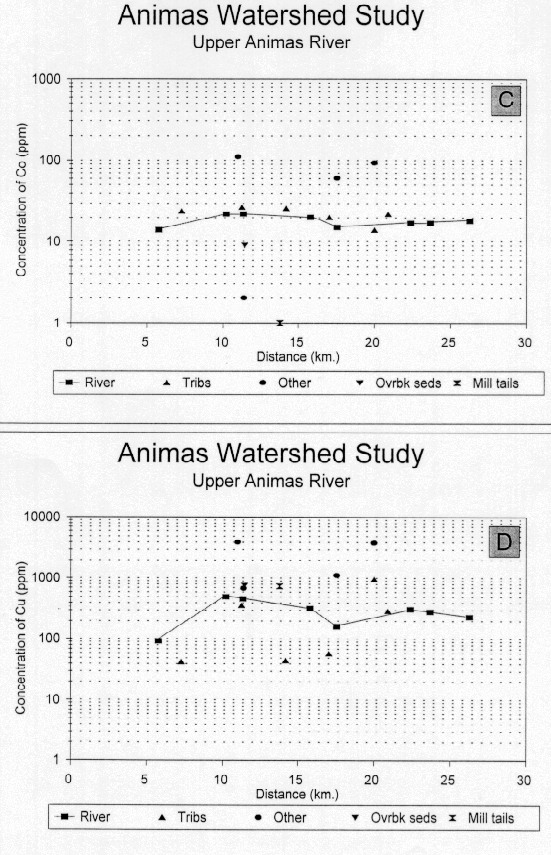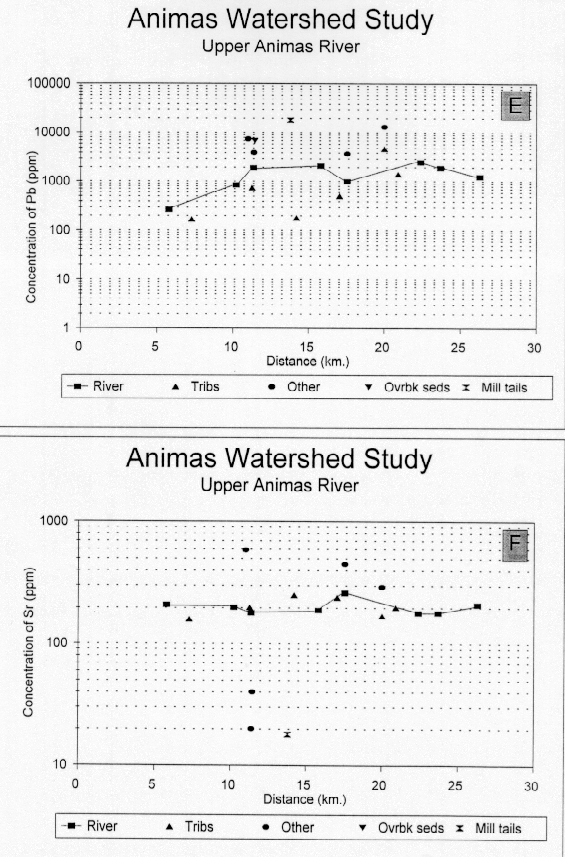Geochemical and lead-isotopic data from bed sediments from the upper Animas River, that is the segment of the Animas River above the confluence with Mineral Creek (25 km), are in figures 26 and 27. One mill site, the Kittimac Mill (13.8 km), was sampled specifically because the mill is immediately adjacent to the upper Animas River. This mill processed material from mines on the north side of Minnie Gulch (Sloan and Skowronski, 1975).
Arsenic concentrations from the 2M HCl-1%H2O 2 digestion data indicate a uniform, albeit a gradually decreasing concentration profile throughout the course of the upper Animas River (figs. 26A and B). The total and the partial digestion data have very similar profiles. The maximum concentration of arsenic found was about 100 ppm (about 55 times CAV) in the upper reach of the Animas River just above the Eureka townsite (a 1996 sample collection site). The arsenic concentration drops steadily along the course of the upper Animas River to 35 ppm just above the confluence with Cement Creek. Arsenic concentrations in Cement Creek and the upper Animas River at their confluence are essentially the same. Arsenic concentrations in the bed sediments from Picayune Gulch near the headwaters are higher than those in the bed sediments at the confluence of Picayune Gulch with the upper Animas River which suggests that the source of elevated arsenic may be from this tributary. Elsewhere along the course of the upper Animas River, the concentration of total and labile arsenic in the stream sediments from the tributaries samples are less than that in the bed sediments of the upper Animas River. Arsenic concentrations in the overbank sediment collected near Eureka are also higher than in the bed sediments at that point indicating transport from upstream during high flow. The efflorescent salt samples collected from along the course of the upper Animas River, except for one sample collected near Eureka, do not concentrate arsenic. The arsenic concentration in the composite surface sample from the Kittimac Mill site is also low. We conclude that the Kittimac Mill site does not appear to be a significant source of arsenic to the bed sediments of the Animas River.
The concentration of cobalt in bed sediments from the upper Animas River (averaging 18 ppm) and its tributaries (averaging 20 ppm) show little variation about the CAV (fig. 26C). The profile is essentially flat and comparable to that from both Mineral and Cement Creeks. The concentration of cobalt is elevated (50-100 ppm) in three of the four water-soluble salt samples.
Copper concentrations in the bed sediments of the upper Animas River at Animas Forks are comparable to those in Cement Creek and much of Mineral Creek (fig. 26D). However, just above the confluence with Eureka Gulch and below the Eureka Mill site, labile copper concentrations exceed 4,000 ppm on the coatings of pebbles and reach almost 500 ppm (about seven times CAV) in bed sediments. The total copper concentration in this sample collected from below the confluence with Eureka Gulch is 550 ppm (eight times CAV) sample and more than 80 percent of the copper is labile. Copper concentrations are also elevated in the sample from the Kittimac Mill site as well as in the sample taken below the braided section of the upper Animas River above Howardsville. Below Howardsville, the total copper concentration in bed sediments drops to 270 ppm below the confluence with Cunningham Creek. Copper concentrations in bed sediments are elevated in the section of the upper Animas River adjacent to the Mayflower Mill (between Boulder Gulch and Arrastra Creek). Copper concentrations in stream sediments from the tributaries are below CAV in the upper reaches of the upper Animas River, but are 2,200 ppm (32 times CAV) in Arrastra Creek, 50 percent of which is labile, and 420 ppm in bed sediments at the confluence of Boulder Gulch, 70 percent of which is labile. From the perspective of aquatic-life standards, it is important to note the high concentrations of copper are present in the white efflorescent precipitates that form by evaporation. Rain storms wash these water-soluble salts into the Animas River creating a spike of dissolved copper and other toxic metals that may exceed the acute toxicity standard for copper for aquatic life.
The concentration profile (fig. 26E) of lead in bed sediments from the upper Animas River is comparable to that of copper. High concentrations (1,600-2,000 ppm or more) characterize the braided stream reaches below Eureka and below the Mayflower mill. The lead-isotopic data discussed below clearly indicate that the source of the lead in this stretch of the upper Animas River is not from Arrastra Creek. With the exception of the sample from Arrastra Creek, lead in stream sediments from the tributaries is substantially lower in concentration than in the bed sediments of the Animas River ranging from about 160 ppm at Animas Forks (12 times CAV) to 700 ppm in Eureka Gulch (more than 50 times CAV). The concentration of lead in stream sediments in Arrastra Creek is 4,000 ppm (more than 300 times CAV). The lead concentration in the stream-sediment sample from lowermost Boulder Gulch is 1,200 ppm, far too high to be from an unmineralized area. We suspect that the bed-sediment sample from Boulder Gulch has been contaminated by material from the tailings ponds upstream from the sample site. Lead concentrations in the overbank sediment from Eureka and from all of the efflorescent salt samples are substantially elevated above that in the bed sediments of the upper Animas River samples. Again, a rain storm would send a spike of water-soluble lead into the river and perhaps could exceed the acute aquatic-life standard for lead. The highest concentration of lead (17,000 ppm) was found in the mill tailings at the Kittimac Mill site.
Strontium concentrations (fig. 26F) are again relatively constant throughout the course of the upper Animas River averaging 190 ppm if the site just below Cunningham Creek is excluded. There is a major change in concentration of strontium in the bed sediments of the Animas River below the confluence with Cunningham Creek which is consistent with the elevated strontium concentrations in the stream-sediment samples from Cunningham Creek and Maggie Gulch. These elevated strontium concentrations reflect the presence of the Leadville and Dyer limestones outcrops in the headwaters of these basins that are too small to show at the scale of the regional geologic map (see fig. 3). Strontium concentrations are highly variable in the precipitates and vary directly with the calcium concentration. Strontium in the sample from the Kittimac Mill site is very low as is the measured calcium concentration. These measurements verify the low acid-buffering capacity of these mill tailings.
The profile and the pattern of both labile and total zinc concentrations (figs. 26G-H) are comparable to those of copper and lead. Total zinc concentrations range between 3,500-4,400 ppm in the reaches of the upper Animas River adjacent to the Eureka and Mayflower mill sites. The overbank sediment and the bed sediments from Cunningham and Arrastra Creeks have zinc concentrations that are higher than those from adjacent segments of the upper Animas River whereas zinc concentrations from other tributaries are lower. The distribution profiles for labile and total zinc concentrations parallel one another. Fifty to 65 percent of the total zinc in bed sediments in the upper Animas River is labile the remainder is present in the sulfide mineral sphalerite. In contrast, 75-80 percent of the zinc from Cunningham and Arrastra Creeks is labile and 85 percent of the zinc in the Boulder Gulch sample is labile indicating a high fraction of the zinc is carried in the iron-hydroxide phase. Zinc concentrations in three of the four precipitate samples range between 16,000 and 27,000 ppm (about 200-350 times CAV). The overbank sample contains a very high concentration of these water-soluble zinc salts as shown by the comparison between the data from the total and the 2M HCl-1%H2O 2 digestion. Zinc in the sample from the Kittimac Mill site is low (310 ppm or four times CAV).
Mineral separates were made from the residue fraction of the leachate sample from sites (fig. 11) collected from the Animas River just above Howardsville ( 95ABS108) and from Cunningham Creek ( 95ABS109). The dominant sulfide mineral in the sample from Cunningham Creek was a ruby-red variety of sphalerite. In contrast, the dominant sulfide mineral present in the Howardsville sample was the blackjack variety of sphalerite there were minor amounts of pyrite present. Magnetite and hematite were also present in about equal abundance in sample 95ABS108. The bulk composition of these heavy-mineral concentrates are given in table 3. An analysis of the magnetic fraction is also given. Note the increased concentration of zinc in the nonmagnetic fractions and the concentration of vanadium in the magnetic fraction. The magnetic fraction contains magnetite only whereas the nonmagnetic fraction from 95ABS108 contains some portion of hematite.Vanadium concentrations in bed sediments from both the tributaries (average 122 ppm) and the upper Animas River (average 105 ppm) are essentially the same and form a flat profile indicating that the changes in ore and ore-related metal concentrations are not the result of hydrologic concentration of heavy minerals in placers (fig. 26H). The vanadium profile of all three main tributaries to the Animas River, that is Mineral Creek, Cement Creek, and the upper Animas River above Silverton, indicate that the streams have an essentially constant supply of vanadium from magnetite and hematite in the Tertiary volcanic rocks (fig. 3).
| ________________________________________________________________________________________________________________________________________________________________________________________ | |||||||||||||||
| Sample2 | Fe |
Ti |
Ag |
As |
Ba |
Cd |
Co |
Cu |
Mn |
Mo |
Ni |
Pb |
Sb |
V |
Zn |
wt. |
wt. |
||||||||||||||
pct. |
pct. |
ppm |
ppm |
ppm |
ppm |
ppm |
ppm |
ppm |
ppm |
ppm |
ppm |
ppm |
ppm |
ppm | |
| 95ABS108-NM | 3.0 |
0.7 |
1.5 |
<500 |
1500 |
50 |
20 |
200 |
1000 |
10 |
<10 |
50 |
<200 |
100 |
5000 |
| 95ABS109-Mag | 20.0 |
0.5 |
<1 |
<500 |
<50 |
<50 |
50 |
10 |
500 |
<10 |
50 |
<20 |
<200 |
300 |
<500 |
| 95ABS109-NM | 7.0 |
1.0 |
<1 |
<500 |
2000 |
<50 |
30 |
100 |
700 |
<10 |
10 |
30 |
<200 |
150 |
2000 |
| ________________________________________________________________________________________________________________________________________________________________________________________ | |||||||||||||||
Lead-isotopic data (figs. 27A and B) show that the mineralization above Animas Forks differs from the Eureka graben vein-type ore. Likewise, lead-isotopic data from stream sediments from Picayune Gulch reflect a different lead-isotopic signature from that of the Eureka graben vein-type ore. Samples from Eureka Gulch and from the Animas River between Eureka and Howardsville reflect the Eureka graben vein-type ore lead signature. The lead-isotopic composition of mill tailings from the Kittimac Mill site is more radiogenic and reflects a third mineralization style in the upper Animas River subbasin. Since ore from the north side of Minnie Gulch was processed at this mill, it is important to note that the lead-isotopic composition of the stream sediments from Maggie Gulch also differs from that of the Eureka graben vein-type ore lead signature. The lead-isotopic signature from both Cunningham and Arrastra Creeks also differs from the previous three mineralization signatures. As the ore from the South Silverton district was more precious-metal rich, it is not surprising to see that the lead-isotopic signatures differ between the Eureka graben vein-type ore lead of which the Sunnyside mine is typical, and the ore from the South Silverton district. The lead-isotopic composition of the bed sediments in the upper Animas River below the confluence of Cunningham Creek changes slightly indicating the addition of this new lead component. The lead-isotopic composition of the sediments from Boulder Gulch indicates that they also contain some of this more radiogenic component of lead, the source of which cannot be determined at this time. Although there are several mineral districts in the upper Animas River subbasin, each of which seem to have differing lead-isotopic signatures, the isotopic composition of lead in the bed sediments of the upper Animas River is dominated by the Eureka graben vein-type ore lead signature as shown by the results in figure 27. Contributions of lead and their associated metals from the other centers of mineralization in the Animas River subbasin appear to be minor.
The isotopic composition of lead in the bed sediments of Cement Creek at the confluence with the Animas River (24 km) is identical to that measured in bed sediments from the Animas River above the confluence, so no calculation of the relative contributions to the total metal in the bed-sediments from Cement Creek can be made from the lead-isotopic data. There are significant changes in the metal concentrations in bed sediments of the upper Animas River between the site above the confluence of Cement Creek and site A-72 below the confluence with Mineral Creek. However, the sampling density does not allow a definitive calculation of the relative amounts of material added to the bed sediments of the upper Animas River by Cement and Mineral Creeks separately. The isotopic composition of lead in the bed sediments of Mineral Creek is somewhat different from that of the upper Animas River above the confluence with Cement Creek. These data will be used below to calculate an upper limit for the percentage of material added to the bed sediments of the Animas River by Mineral Creek.


 Figure 26. Metal distribution profiles (A-H) for the upper Animas River above Silverton metal concentrations
Figure 26. Metal distribution profiles (A-H) for the upper Animas River above Silverton metal concentrations